
How to understand the WGCNA analysis in publications? (1/2)
Understanding WGCNA Analysis in Publications
Harnessing the Power of WGCNA Analysis in Multi-Omics Data
WGCNA Explained: Everything You Need to Know
Metabolomic Analyses: Comparison of PCA, PLS-DA and OPLS-DA
Principal Component Analysis (PCA) is a cornerstone technique in omics research, empowering scientists to navigate the complexities of high-dimensional datasets. From metabolomics to genomics, PCA excels at dimensionality reduction, condensing intricate data into a more manageable format while preserving key information. This unveils hidden patterns and trends within the data, enabling researchers to construct robust frameworks for understanding biological processes.
Principal Component Analysis, commonly abbreviated as PCA, stands as a pivotal unsupervised multivariate statistical technique. It is predominantly utilized for the analysis of intricate, high-dimensional datasets that are characteristic of omics research disciplines, such as metabolomics.
In such contexts, PCA serves as a tool for data dimensionality reduction, distilling the essence of complex datasets while maintaining fidelity to the original information. This enables the construction of robust mathematical frameworks that encapsulate the metabolic profile characteristics of the subjects under scrutiny.
The operational mechanism of PCA involves the application of orthogonal transformations to convert a set of potentially intercorrelated variables into a set of linearly uncorrelated variables, termed principal components (PCs). Simply put, PCA compresses original data into n principal components to describe the characteristics of the original dataset. The first principal component (PC1) captures the most pronounced feature, with subsequent components (PC2, PC3, etc.) representing increasingly subtler aspects of the data.
This analysis method is often used to explore how a few principal components can reveal the internal structure among multiple variables, deriving a few principal components from the original variables to retain as much information as possible while being mutually uncorrelated.
The PCA analytical outcomes are customarily depicted through two distinct graphical representations: score plots and s-plot plots.
The score plot, particularly in its two-dimensional rendition, is favored for its utility in providing a wealth of insights. This plot delineates the first (PC1) and second (PC2) principal components, with the respective percentages indicating the variance each component accounts for within the dataset. Each plotted point corresponds to an individual sample, differentiated by color to represent distinct groups, with 'Group' denoting the various sample categories. The three-dimensional score plot introduces an additional dimension, with the X-axis for PC1, Y-axis for PC3, and Z-axis for PC2.
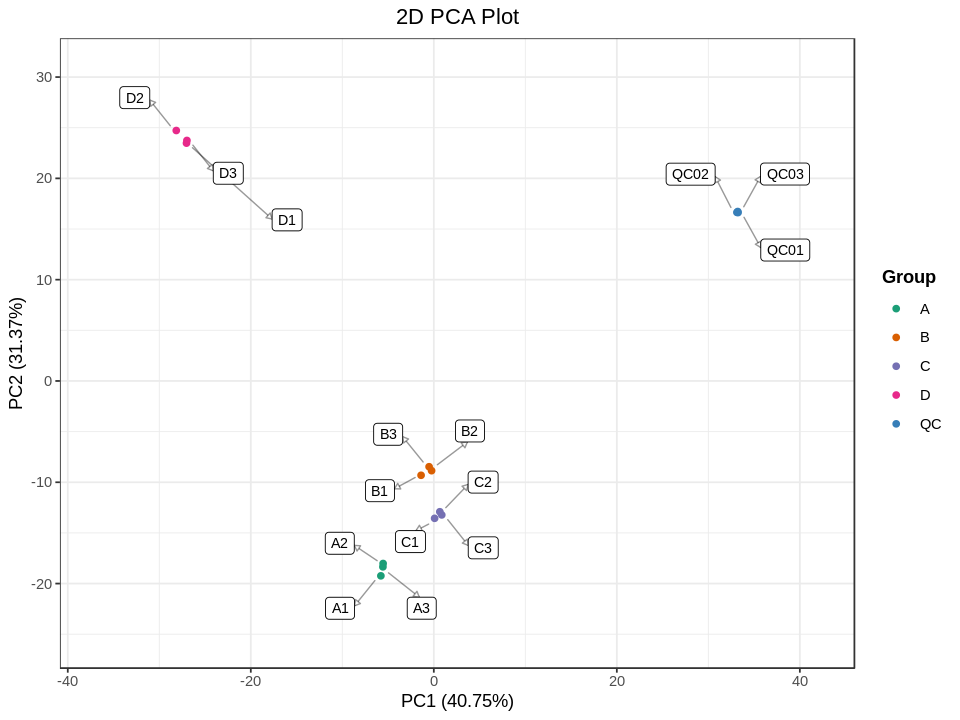
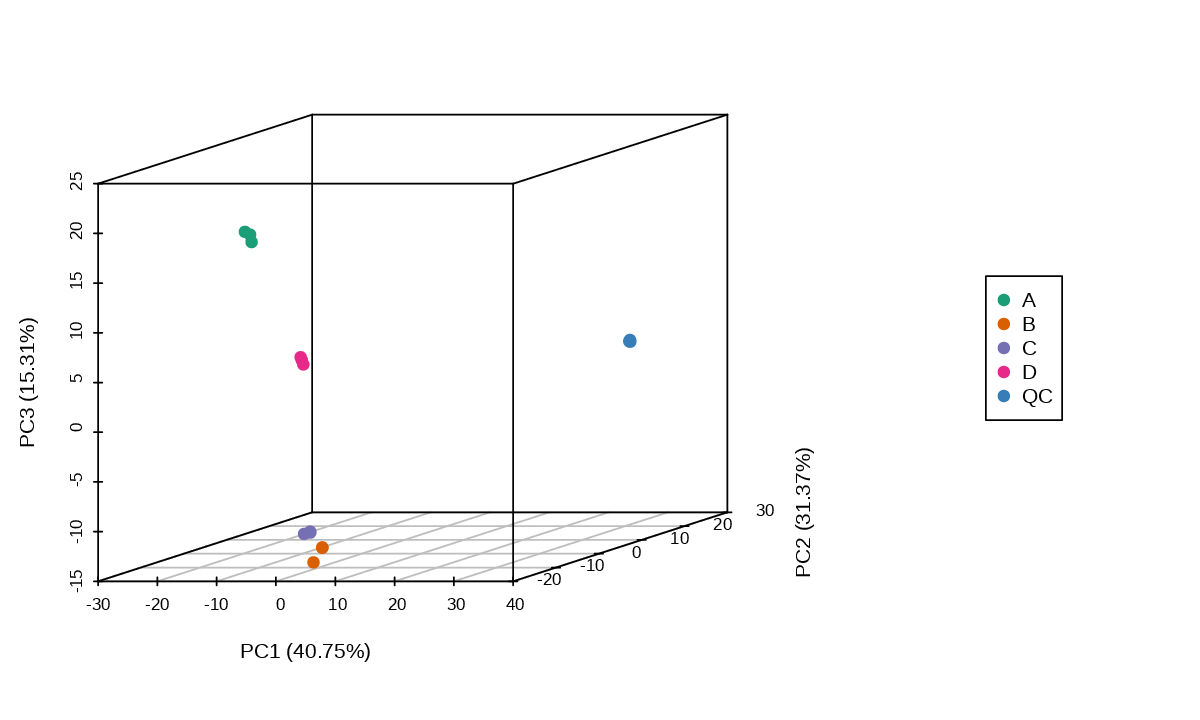
Interpretive Framework for PCA Plots Executing PCA on a dataset affords an initial assessment of the metabolic variance between different groups and the intra-group variability. The primary applications of PCA plots are delineated as follows:
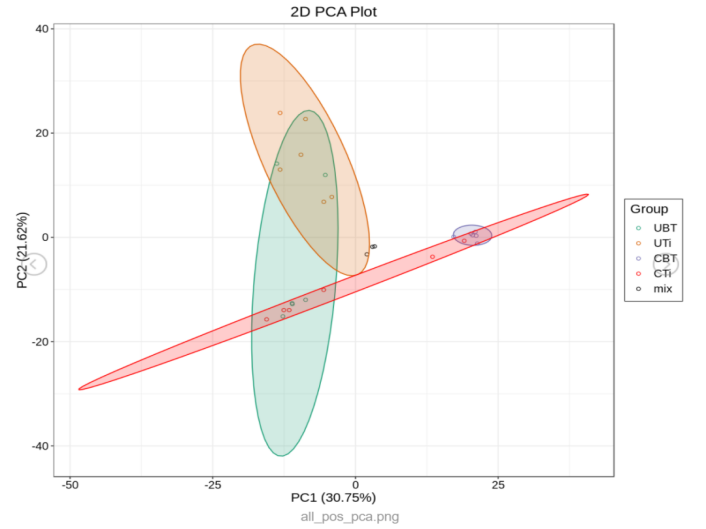 Quality Control (QC) samples are meticulously prepared by pooling sample extracts, serving as a benchmark for evaluating the consistency of the analytical process. The inclusion of a QC sample at regular intervals during analysis ensures the integrity of the process. Given that QC samples are technical replicates, their close proximity on the PCA plot is both expected and indicative of methodological rigor.
Quality Control (QC) samples are meticulously prepared by pooling sample extracts, serving as a benchmark for evaluating the consistency of the analytical process. The inclusion of a QC sample at regular intervals during analysis ensures the integrity of the process. Given that QC samples are technical replicates, their close proximity on the PCA plot is both expected and indicative of methodological rigor.
The intra-group metabolite distribution among biological replicates is anticipated to exhibit a high degree of similarity, manifesting as a clustered pattern on the PCA plot. Samples that deviate from this pattern, particularly those situated beyond the 95% confidence ellipse, may be classified as outliers. In scenarios with an ample sample pool, such outliers are typically subjected to exclusion.
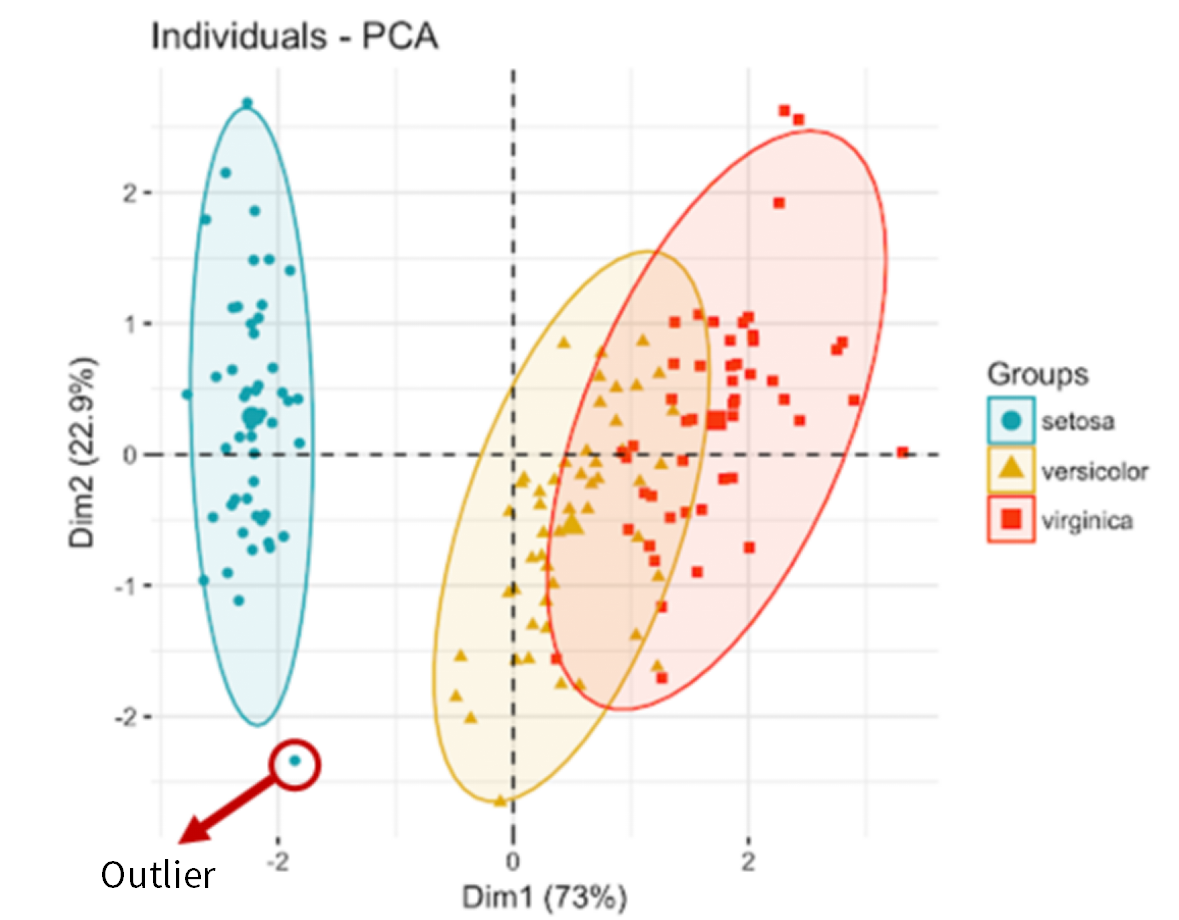
The two-dimensional PCA plot, featuring axes for PC1 and PC2, facilitates a visual assessment of group differences. By drawing lines perpendicular to both axes from the origin, one can apply a quartet of principles for analysis:
Is there distinct separation on the 1st/2nd principal component?
Are there observable trends?
Is one group disproportionately represented?
Are there discernible patterns of group clustering? (e.g., by variety, treatment, etc.)
For instance, if separation is evident on the 1st/2nd principal component without a dominant group or clear clustering trend, subsequent analyses may prioritize the comparison of differential metabolites between distinct varieties or explore the temporal dynamics of metabolite variation, potentially in conjunction with K-means clustering.
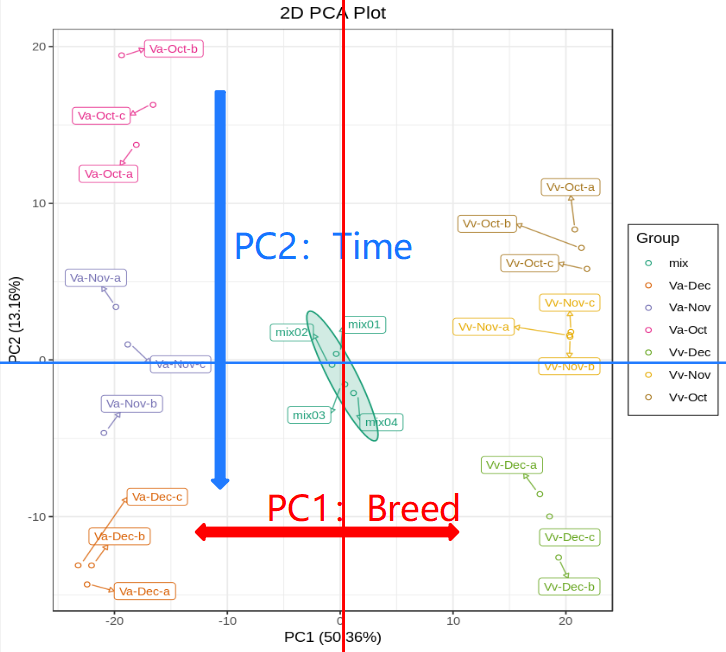
Descriptive Analysis of PCA Results The articulation of PCA outcomes is nuanced and contingent upon the specific findings:
① Distinct Separation on the 1st/2nd Principal Components
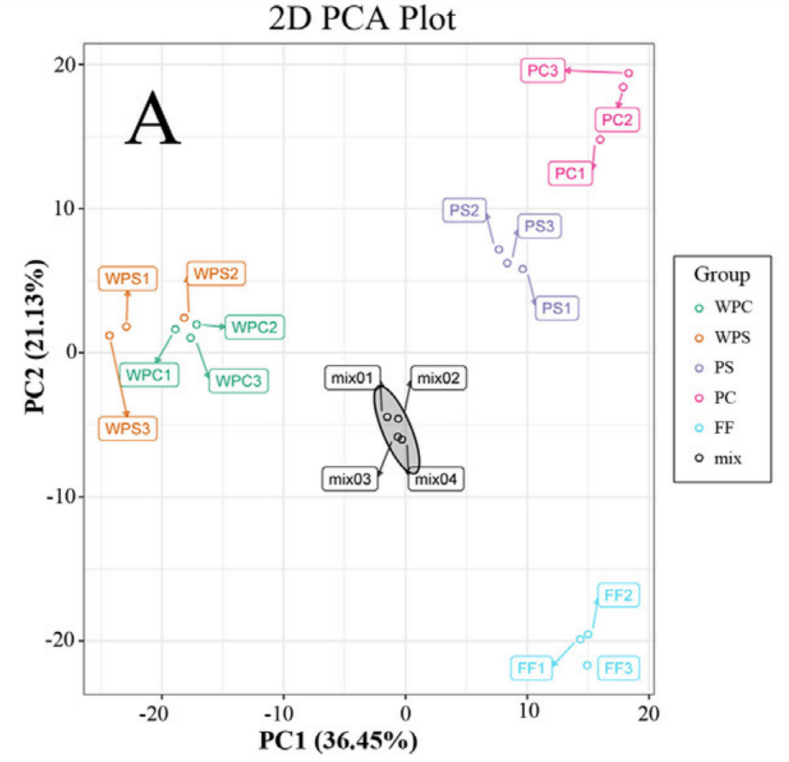
PC1 elucidates **% of the dataset's characteristics, whereas PC2 accounts for **%.
② Separation with a Coherent Trend on Both Principal Components
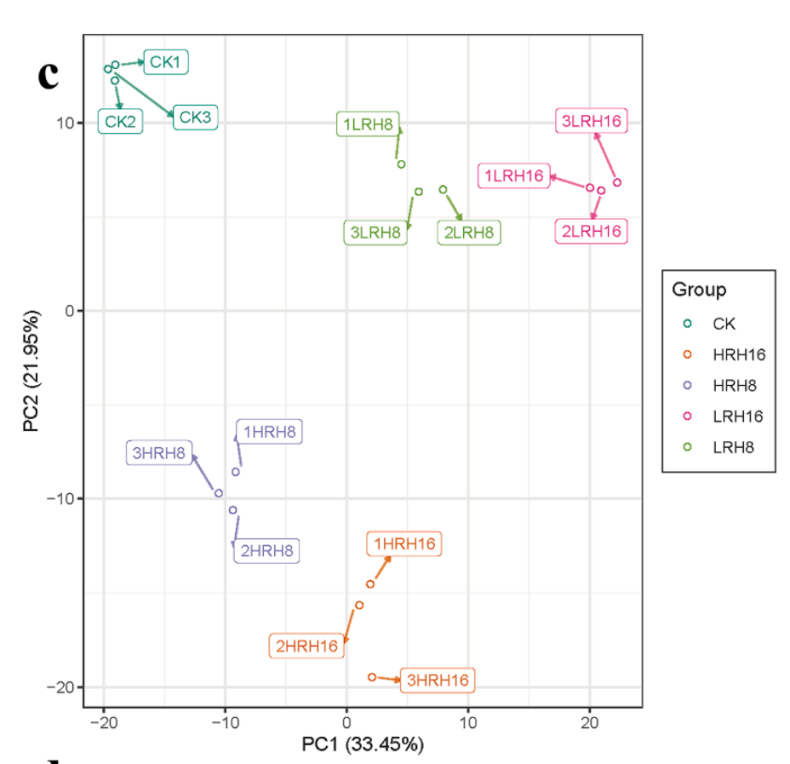
If both components exhibit regular patterns:
PC1 and PC2 each reveal separations based on differential treatments and temporal factors, respectively, with PC1 explaining **% and PC2 elucidating **% of the dataset.
If only PC1 demonstrates a pattern:
Collectively, PC1 and PC2 account for **% of the variance among samples, with pronounced patterns across treatments but not temporally.
③ Separation with Dominance of a Single Group
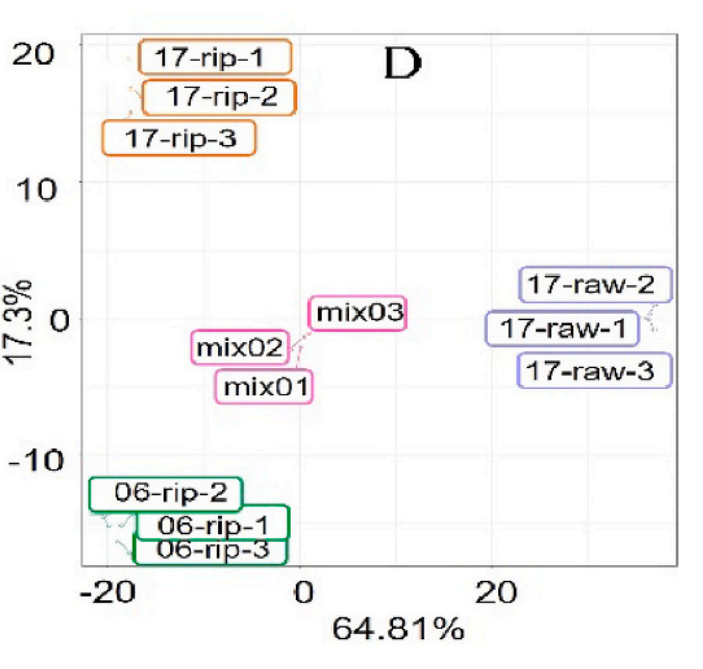
PC1, which accounts for **% of the dataset, reveals a pronounced divergence between Group A and other groups. Meanwhile, PC2, elucidating **%, indicates a separation between Group B and the remainder, suggesting the most significant disparities lie between Group A and the others, with Group B following suit.
④ Separation with Defined Grouping Trends
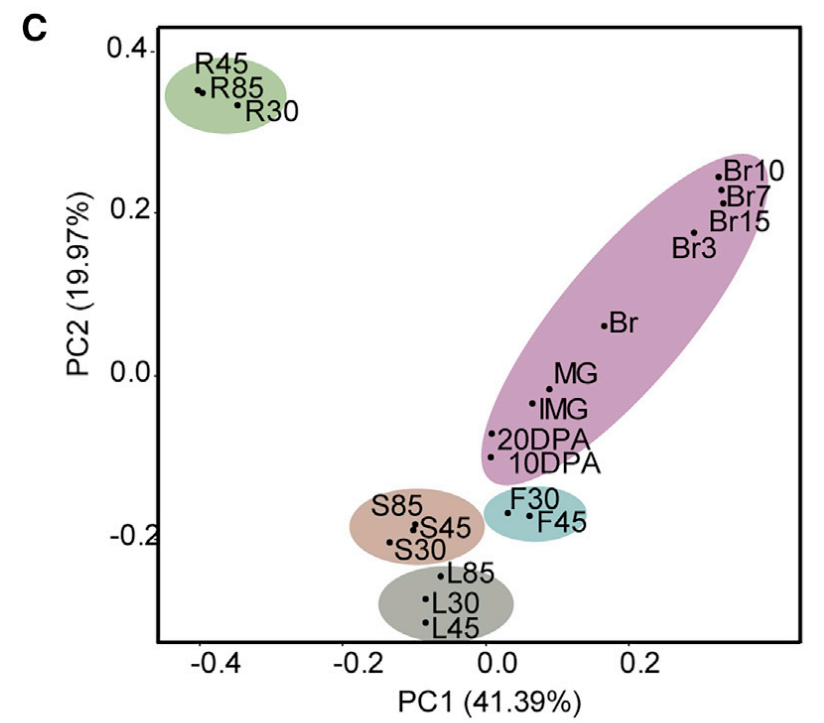
The dataset is demarcated into * distinct regions, implying that each group possesses a unique metabolic signature. Group 1 may encompass samples from specific categories; Group 2 from others; and so forth, with intra-group samples exhibiting congruent metabolite profiles.
An intricate challenge in PCA is encountered when sample groups intermingle without distinct separation. To address this, consider the following investigative steps:
Re-evaluating Grouping Criteria It is imperative to reassess the criteria for sample grouping to ascertain whether it is not the primary determinant of metabolite composition. For instance, if groups are categorized based on cattle feeding duration but PCA does not reveal a separation, it is prudent to explore other influential factors, such as lineage, which may significantly impact the metabolome. This does not invalidate PCA but rather suggests that feeding duration may not be the predominant factor.
Identifying and Addressing Outliers If the initial inquiry does not yield conclusive results, it is essential to scrutinize the dataset for outliers—samples that fall beyond the confidence circle or are significantly distant from their group peers. With an adequate sample size, the exclusion of such outliers, followed by a reanalysis using PCA, can often lead to more refined outcomes.
PCA offers a powerful lens for dissecting omics data, revealing group differences, identifying outliers, and visualizing metabolic variances. By interpreting PCA plots effectively, researchers can gain invaluable insights into biological systems. This guide has equipped you with the foundational knowledge to leverage PCA and unlock the hidden treasures within your omics datasets.
Now that you're armed with this powerful tool, MetwareBio can help you unlock its full potential. At our Boston laboratory, we offer extensive metabolomics and multi-omics testing services, alongside comprehensive data analysis services. Additionally, our free and user-friendly Metware Cloud Platform allows you to seamlessly analyze your multi-omics data, all in one place. Have questions? Our team is here to offer guidance and support every step of the way, ensuring you get the most out of your omics data analysis.
